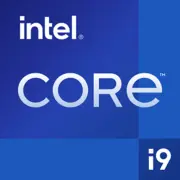Intel Core i9-11900K

Intel Core i9-11900K: Architecture, Compatibility, and Practical Application in 2025
An updated look at the flagship from years past in the context of modern tasks
Key Specifications: Rocket Lake in Detail
The Intel Core i9-11900K processor, released in 2021, is the last representative of the 11th generation built on a 14nm process. Despite its age, it remains relevant in 2025 for certain scenarios.
Architecture and Process
- Codename: Rocket Lake-S.
- Architecture: Cypress Cove (a refined version of Sunny Cove from the 10nm Ice Lake, adapted for 14nm).
- Cores and Threads: 8 cores, 16 threads.
- Frequencies: Base — 3.5 GHz, maximum turbo frequency — 5.3 GHz (Thermal Velocity Boost).
- Cache: 16 MB L3.
- TDP: 125 W (real consumption under load reaches 250-300 W).
Key Features
- PCIe 4.0 support (20 lanes).
- Integrated graphics: Intel UHD Graphics 750 (32 EU).
- Intel Adaptive Boost and Thermal Velocity Boost technologies for automatic overclocking.
Performance
- In Geekbench 6 (2025): 1691 (single-core), 8782 (multi-core).
- In games (e.g., Cyberpunk 2077 with RTX 4070), shows 90-110 FPS at 1440p.
Compatible Motherboards: LGA 1200 Socket and Chipsets
The i9-11900K requires a motherboard with the LGA 1200 socket and 500 series chipsets:
- Z590: Best choice for overclocking (supports PCIe 4.0, improved VRM). Examples: ASUS ROG Maximus XIII Hero ($250–$300 in 2025).
- B560: Budget option with unlocked support for DDR4-3200 memory. Suitable for mid-range builds (e.g., MSI B560M PRO-VDH, $120–$150).
- H510: For office PCs (no overclocking, minimal ports).
Selection Considerations
- BIOS updates may be required for older 400 series boards (e.g., Z490).
- For PCIe 4.0 SSDs (e.g., Samsung 980 Pro), use slots connected to the CPU rather than the chipset.
Memory: DDR4 and Limitations
The i9-11900K supports only DDR4:
- Officially: up to 3200 MHz.
- With overclocking: up to 5333 MHz (on Z590 boards).
- Recommended modules: 2x16 GB DDR4-3600 CL16 (e.g., G.Skill Trident Z Neo, $120–$150 for the kit).
Why not DDR5?
The Rocket Lake architecture is not designed for DDR5. This is a drawback for future upgrades, but a plus for users with existing DDR4 setups.
Power Supplies: Power Calculation
With a TDP of 125 W, the actual power consumption of the processor under load reaches 250-300 W (especially when overclocked).
Recommendations:
- Minimum: 650 W (for systems with an RTX 4060 level graphics card).
- Optimal: 750-850 W (for RTX 4080/4090 or overclocking).
- Examples: Corsair RM750x (80+ Gold, $110–$130), Seasonic PRIME GX-850 ($160–$180).
Important: Do not skimp on the PSU — unstable power can lead to throttling.
Pros and Cons of the i9-11900K in 2025
Advantages:
1. Single-core performance: 5.3 GHz is still competitive for gaming and IPC-dependent applications.
2. Price: New processors in 2025 cost $250–$300 (compared to $500–$600 in 2021).
3. Compatibility with DDR4: Cheaper upgrade for owners of older systems.
Disadvantages:
1. High thermal output: Requires robust cooling.
2. 8 cores: Lags behind in multi-threaded tasks compared to the Ryzen 9 5900X (12 cores).
3. No PCIe 5.0/DDR5: A limitation for future upgrades.
Usage Scenarios
1. Gaming: Ideal for 1080p/1440p with high FPS (e.g., Valorant — 400+ FPS).
2. Work tasks: Video editing in Premiere Pro, 3D rendering in Blender (but slower than Ryzen 9).
3. Multimedia: Streaming (NVENC on the graphics card reduces CPU load).
Practical Example: A streaming build (i9-11900K + RTX 4070 + 32 GB DDR4) handles encoding in OBS without lag.
Comparison with Competitors
- AMD Ryzen 7 5800X: Cheaper ($200–$250), 8 cores, but lower frequency (4.7 GHz). Better at multi-threading due to Zen 3 architecture.
- Intel Core i5-13600K: Newer (2023), 14 cores (6P+8E), DDR5, but more expensive ($300–$350).
- Ryzen 9 5900X: 12 cores for $350 — a choice for rendering.
Conclusion: The i9-11900K excels in single-threaded performance but falls short in multi-threaded tasks.
Building Tips
1. Cooling: Minimum — tower cooler (Noctua NH-D15, $90) or AIO 240 mm (NZXT Kraken X53, $120).
2. Case: Good airflow (Lian Li Lancool III, $150).
3. Motherboard: Z590 with 12+ phase VRM (e.g., Gigabyte Z590 AORUS Elite).
4. BIOS Update: Check compatibility before purchasing.
Final Conclusion: Who Should Choose the i9-11900K?
This processor is worth choosing if:
- You already have an LGA 1200 platform and want an upgrade without replacing the motherboard and memory.
- Gaming and single-threaded tasks are a priority over rendering.
- Budget is limited to $300, and new CPUs from the 13th/14th generation seem excessive.
In 2025, the i9-11900K is not top-tier, but it is a rational choice for gamers and enthusiasts who value the balance between price and performance.
Basic
CPU Specifications
Memory Specifications
GPU Specifications
Benchmarks
Compared to Other CPU
Share in social media
Or Link To Us
<a href="https://cputronic.com/cpu/intel-core-i9-11900k" target="_blank">Intel Core i9-11900K</a>